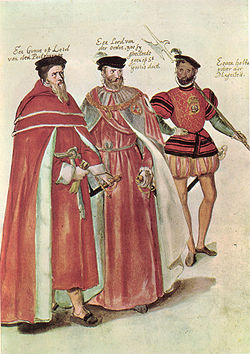
Lucas de Heere
Encyclopedia

Lucas de Heere was a Flemish
County of Flanders
The County of Flanders was one of the territories constituting the Low Countries. The county existed from 862 to 1795. It was one of the original secular fiefs of France and for centuries was one of the most affluent regions in Europe....
portrait painter
Portrait painting
Portrait painting is a genre in painting, where the intent is to depict the visual appearance of the subject. Beside human beings, animals, pets and even inanimate objects can be chosen as the subject for a portrait...
, poet and writer.
De Heere was a Protestant
Protestantism
Protestantism is one of the three major groupings within Christianity. It is a movement that began in Germany in the early 16th century as a reaction against medieval Roman Catholic doctrines and practices, especially in regards to salvation, justification, and ecclesiology.The doctrines of the...
and became a refugee from the Dutch Revolt
Dutch Revolt
The Dutch Revolt or the Revolt of the Netherlands This article adopts 1568 as the starting date of the war, as this was the year of the first battles between armies. However, since there is a long period of Protestant vs...
against Philip II of Spain
Philip II of Spain
Philip II was King of Spain, Portugal, Naples, Sicily, and, while married to Mary I, King of England and Ireland. He was lord of the Seventeen Provinces from 1556 until 1581, holding various titles for the individual territories such as duke or count....
, who tried to suppress Protestantism. De Heere had to flee to England
England
England is a country that is part of the United Kingdom. It shares land borders with Scotland to the north and Wales to the west; the Irish Sea is to the north west, the Celtic Sea to the south west, with the North Sea to the east and the English Channel to the south separating it from continental...
, but was able to return after the Pacification of Ghent
Pacification of Ghent
The Pacification of Ghent, signed on November 8, 1576, was an alliance of the provinces of the Habsburg Netherlands for the purpose of driving mutinying Spanish mercenary troops from the country, and at the same time a peace treaty with the rebelling provinces Holland and Zeeland.-Background:In...
in 1576.
He was very popular during his career and became immensely rich. His portrait of Katheryn of Berain
Katheryn of Berain
Katheryn of Berain , sometimes called Mam Cymru , was a Welsh noblewoman noted for her four marriages and her extensive network of descendants and relations.-Family:...
is held by the National Museum Cardiff
National Museum Cardiff
National Museum Cardiff is a museum and art gallery in Cardiff, Wales. The museum is part of the wider network of Amgueddfa Cymru – National Museum Wales...
. He painted a head of Phillip II from the life in 1553, as a letter of Cardinal Granvelle documents; this is presumed to be the painting now in the Prado.
In England he trained other young Netherlanders: John de Critz
John de Critz
John de Critz or John Decritz was one of a number of painters of Flemish and Dutch origin active at the English royal court during the reigns of James I of England and Charles I of England...
, probably Marcus Gheeraerts the Younger
Marcus Gheeraerts the Younger
Marcus Gheeraerts was an artist of the Tudor court, described as "the most important artist of quality to work in England in large-scale between Eworth and Van Dyck" He was brought to England as a child by his father Marcus Gheeraerts the Elder, also a painter...
, and possibly as well the English Robert Peake the Elder
Robert Peake the Elder
Robert Peake the Elder was an English painter active in the later part of Elizabeth I's reign and for most of the reign of James I. In 1604, he was appointed picture maker to the heir to the throne, Prince Henry; and in 1607, serjeant-painter to King James I – a post he shared with John De Critz...
.
See also
- Artists of the Tudor courtArtists of the Tudor courtThe artists of the Tudor court are the painters and limners engaged by the monarchs of England's Tudor dynasty and their courtiers between 1485 and 1603, from the reign of Henry VII to the death of Elizabeth I....
- Cultural depictions of Philip II of SpainCultural depictions of Philip II of SpainPhilip II of Spain has inspired artistic and cultural works for over four centuries, as the most powerful ruler in the Europe of his day, and subsequently a central figure in the "Black Legend" of Spanish power. The following list covers representations of him in drama, opera, film, novels, and verse...

